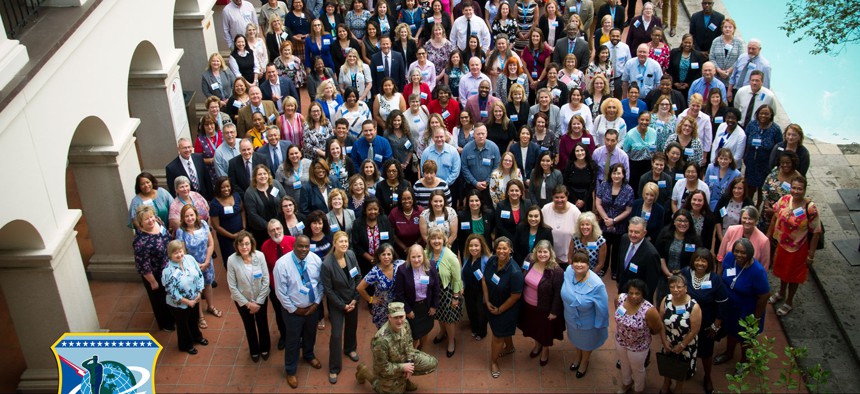
The Air Force’s Personnel Center hosted the 2019 Civilian Personnel Training Summit in San Antonio, Texas, July 22-26, 2019. U.S. Air Force / Angelina Casarez
National Security Is Made of People
We need a way to measure the readiness of our civilian national-security workforce. Then we need to fix it.
“I am shocked by the declining state of our civilian workforce. No enemy in the field has done more harm to this vital component of our national security than the cuts, neglect, and toxic rhetoric of the past decade”...said no Defense Secretary or Secretary of State ever.
For several years, members of Congress and senior defense officials have worried, dramatically and out loud, about the state of military readiness, devoting bipartisan harangues and billions in emergency spending to repairing a crisis that never quite seems to end. As typically understood, military readiness—the ability of forces to do what the nation asks of them—is worth careful consideration. The Department of Defense spends remarkable effort and resources in sustaining and measuring readiness, while shushing public debate. The national-security-wonk world devotes commensurate time assessing whether military readiness considers the right measures, or if a crisis really exists, or if we can define what forces should be ready for. Regardless, there is a common understanding that if military readiness is unsound, U.S. national security may be at risk.


Remarkably, there is no such common understanding of the readiness of the national security civilian workforce—no metrics, no tirades, no constituencies, no bestowing value. There is increasing recognition that great power competition will not be waged principally in the military sphere, and civilian domains will be vital in this era. But the most bipartisan, universal assessments of the national security personnel required to execute in those domains is disdain: lazy bureaucrats, unelected conspirators, back-office functionaries, retired-in-place cubicle-dwellers. The most consistent policy agendas applied to the national security workforce is to cut them.
The practice of denigrating and ignoring the civilian men and women who are as much a part of our national security as their uniform counterparts has to end. Sustaining our military advantage will not be a sufficient measure to keep our strategic advantage, nor is the military capable of fulfilling government demands in economic, diplomatic, ideological, or technology competition. Indeed, to understaff and undermanage civilian counterparts does our uniformed force an enormous disservice. We measure what we value, we manage what we measure. Why, then, are there no national security civilian readiness metrics?
The time to develop them is now. With its democratic values, open economy, and diverse citizenry, the United States possesses a number of distinct advantages in the development of human capital, and public service remains a top career choice for young people. But taking these for granted will squander them. As I wrote earlier this year, the federal national security workforce is entering a perfect storm shaped by workforce demographic trends, short-sighted leadership, slow adaptation to modern challenges, and inflexible talent acquisition and management. Young talent—a key source for innovation and fresh thinking—is wildly underrepresented. Repeated hiring freezes, wage freezes, and below-average pay increases have crushed morale and retention, with no evidence that congressional or policy leaders considered their impact on the future workforce. Mid- and senior-level talent is departing in disproportionate numbers across key agencies. Government hiring practices are antiquated and slow, and they deter as much talent as they acquire. High-demand technical talent is wary of government service, often for excellent reasons. Imploring testimony and commentary highlights “the demolition of U.S. diplomacy” or the weakening of civilian control.
Related: Great Power Rivalry Is Also a War For Talent
Related: State Dept. IG: Hiring Freeze Hurt Border Security, Counterterrorism, and Other Priorities
Related: Cutting Language Training Is the Latest Foolish Retreat from Global Engagement
In a future crisis, the people required to manage such events on behalf of the nation will not be in the right place. They are not waving, but drowning.
If the White House or Congress decided to throw a life preserver, how might they define national security workforce readiness? It’s hard enough to define readiness for military units, but a national security civilian equivalent might include the ability of the national security civilian workforce to: accomplish the tasks demanded by the president; to meet assigned missions; and to conduct the range of policymaking (informing, developing, communicating, implementing, or evaluating) on matters of urgent national security interest. These are a start, but worth iterating on. Routinely described as an art, not a science, the prospect of quantifying the effectiveness of policymaking is challenging.
But the ingredients of effective national security policymaking may be easier to understand. To make its assessments, the Defense Readiness Reporting System measures personnel, equipment on hand, supply/maintenance, and training—a limited metric, as Todd Harrison has written, for only evaluating inputs instead of outputs, and presuming the inputs on hand are right correct ones. Still, to start, national security readiness metrics might assess:
- The number and trend of national security personnel fluent in languages relevant for great power competition (e.g., China and U.S-Asia allies and partners).
- The number and trend of national security personnel with experience and expertise in area studies relevant for great power competition.
- The number and trend of technical personnel with experience and expertise in emerging technologies with significance to great power competition.
- The number and trend of economic technical personnel with experience and expertise in economic security and statecraft career fields.
Raw numbers of personnel don’t say much about effectiveness, as DOD acknowledges in its own readiness measures, and evaluations on how good civilian personnel are at their underlying tasks don’t exist in the same way they do on the uniformed side. But proxies of such assessments are possible if you draw out what environment is necessary for good policy to flourish. These are subjective, but such measures might include:
- Availability and growth in funding for priority substantive, managerial, and technical professional development of the national security civilian workforce.
- Effective use of talent management systems with high-quality and accessible data inputs and modern evaluative metrics for career transitions and promotion.
- Retention and return metrics on high-value recruits.
- Agency and national security workforce diversity metrics.
- Low barriers to talent movement between departments and agencies, as well as on- and off-ramps between federal, academia, and private employment.
- Low barriers to accessing external expertise for policy challenges (from consultative agreements to temporary clearances to physical visit barriers).
- Time required for national security nominees to secure Senate confirmation.
- Time and steps required to launch diplomatic and development initiatives requiring congressional approval (compared to time and steps required to launch security force assistance missions).
- Frequency of authorization legislation for key components of the national security bureaucracy, and quality of deliberative and transparency development of authorization legislation.
But much of what ails the national security workforce is arguably cultural. As I wrote in April, “painting bureaucrats as lazy or even evil has become an accepted, if short-sighted, political position across partisan lines, to include by executive branch leaders...Trust in the assessments of the intelligence community, the loyalty of the diplomatic corps, and the judgment of the average policymaker has been questioned by senior officials, publicly and privately.” A similarly negative tenor shapes the relationship between the national security establishment and key technology innovation hubs. Civil servants themselves rightfully question whether they are being adequately protected from political retribution. And across the board, transparency on national security objectives and activities remains low. In short, it’s popular to hate national security bureaucrats—and for those bureaucrats to hold the American people at arm’s length—and that’s bad for America. Metrics to assess this environment might include:
- Instances of toxic and positive rhetoric on national security bureaucrats from the White House, federal agencies, and Congress.
- Senior political appointee commitment to workforce development, such as leader-driven human capital strategies and performance reviews considering workforce health.
- Procurement, research and development relationships between national security agencies and technology innovation hubs.
- Workforce surveys on responsiveness of inspectors general, EEOC, Merit Systems Protection Board, and other workforce protection mechanism.
- On-the-record press availabilities and public speaking engagements by confirmed senior officials.
The national security workforce rightfully has a reputation of exclusivity, secrecy, and traditionalism. While such an atmosphere has benefits in high-risk environments, it also serves as an obstacle to the sort of talent these agencies should want to draw from. Barriers that deter national security workforce hires are some of the most measurable factors to include any readiness determination, such as:
- Number of positions requiring high-level security clearances;
- Overlap between security clearance review flags and desirable hiring traits, such as international connections and experience.
- Time required for fully cleared national security hires between preliminary offer and on-boarding.
- Pay metrics for comparable career and educational fields in the government and private sectors.
- Formal benefit availability comparison between government and private sectors.
- Informal benefit availability (e.g., flexible workplaces) comparison between government and private sectors.
These are obviously notional; you can surely develop better ones—and you should! Today, not only are there no such measures, there is no constituency for caring about what they evaluate, and no political benefit to pursuing that. That must change if the United States is to even claim it is engaging in great power competition.
With such metrics—yours or mine—perhaps someday a senior official will declare: “if we do not maintain our commitment to remain strong in the cubicle, on the cable crosshatch, and yes, in the embassy, then we will pay the butcher’s bill in blood, and we will forever lose the precious gift of our freedom.” Or…maybe not.
This commentary is part of the American Readiness Project, a yearlong joint effort by Defense One and the Center for a New American Security to investigate America's desire and preparedness for global security leadership.




